I promised a full review of Zendikar this week, but I want to wait until the full set is spoiled before I publish my review. Rest assured, I will talk about the impact of Mindbreak Trap and other cards next week. Instead, I have a split article. First, I examine the July/August metagame trends in Vintage, resulting from the restriction of Thirst For Knowledge. The second half of the article is an in-depth analysis of the StarCityGames.com $5000 Charlotte Legacy Open results, with a full metagame breakdown!
The July/August Vintage Metagame Report
In June, the DCI put Tezzeret under the knife, and restricted Thirst For Knowledge.
From the printing of Tezzeret the Seeker, Mana Drain decks began to dominate the format.
If you take a look at this chart, which runs from the moment that Gifts was restricted and Gush was unrestricted through April of this year, the problem is even more evident.
In particular, Tezzeret was totally dominant. Here is a graph from the March/April metagame report, showing Tezzeret representations in Top 8s:
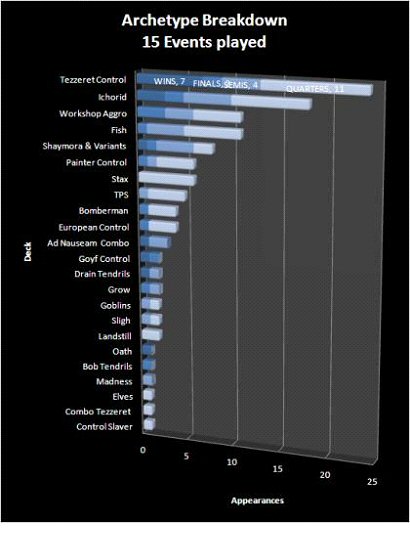
Not only was Tezzeret by far the most successful deck in making Top 8s, it was also far and away the most likely tournament winner, winning half of the tournaments in any given time period.
But that wasn’t the end of it. In May and June, Tezzeret rose to 26% of the Top 8s, and Mana Drain decks in particular rose to 45.6% of Top 8 decks. (Thanks to Troy Costistick for his May/June metagame report here!
Something had to be done. So, in June, Thirst For Knowledge was restricted in an effort to bring greater balance to the metagame. Was the DCI successful? That’s what we intend to find out today.
The July/August Metagame Breakdown by Archetype
There were nine tournaments in July and August with 33 or more players in the U.S. and elsewhere, for a total of 72 possible Top 8 spots. Here’s what happened:
11 Tezzeret (1,2,3,3,3,3,5,6,6,8,8)
9 Fish (1,1,1,2,4,6,6,7,7) [(BUG Fish (1,2,7) UGW Fish (1,6) UBW Fish (1) UW Fish (6) UR Fish (7) Mono Blue Fish (4)]
8 Stax (2,4,4,4,5,5,6,8)
6 MUD (3,3,4,5,7,8)
5 TPS (1,2,3,8,8)
5 Beats (4,4,5,6,8) [GW Beats (4,8) RG Beats (4), BG Beats (5) BW Beats (6)]
4 Drain Tendrils (1,2,2,7)
4 Dredge (1,1,5,5)
4 Oath (2,4,6,7)
3 Painter (2,5,6)
3 European Storm Combo (1,2,8)
2 Ad Nauseam (5,6)
Decks with only one appearance in top 8s:
Coatl Control
UW Tezzeret Mid-Range Beatdown
Bob Tendrils
Mono Red Workshop
European Control
Steel City Vault
Next Level Vault
Bomberman
Here’s what that looks like graphically:
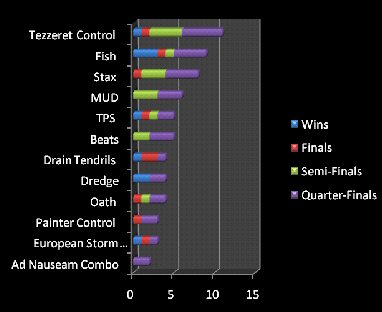
You can see from this chart that Tezzeret has the most Top 8 appearances, but only one of those Tezzeret lists won a tournament, compared to three Fish decks.
Here is what it looks like as a pie:
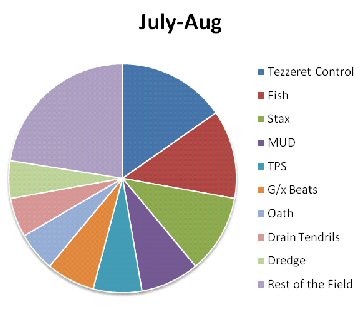
As you can see, Tezzeret is still the largest part of the field, but it’s slice of the pie is not nearly as bad as it was in May/June.
In this dataset, we see that Tezzeret, Fish, and Stax decks are competing at the top of the metagame. Although Tezzeret had more appearances, Fish decks had more tournament wins. Importantly, however, Tezzeret won the most important tournament in this time period: The Vintage Championship. For that reason, there is no clear tournament victor or obvious best deck in this dataset.
Archetypes as a Percentage of the Top 8 Field
Tezzeret: 15.3%
Fish: 12.5%
Stax: 11.11%
MUD: 8.33%
TPS: 6.9%
G/x Beats: 6.9%
Drain Tendrils: 5.6%
Dredge: 5.6%
Oath: 5.6%
“Rest of the Field”: 22.22%
How does that compare from the previous time period?
May/June Percentages:
Tez Control: 26%
Other Drain decks: 12.6%
Dredge: 11.6%
MUD: 7.8%
The Field: 42%
Tezzeret fell from 26% of Top 8s to 15%, a tremendous improvement. The restrictions clearly had an effect, contrary to those who said they would not or that “nothing changes.”
The July/August Breakdown by Engine
Tom LaPille said that the DCI uses its restricted list policy to try and create better balance among the format’s major “pillars”: Force of Will (represented by Mana Drain decks), Dark Rituals, Bazaar of Baghdad, and Mishra’s Workshop.
How do these pillars compare in this time period?
22 Mana Drain decks: 30.6% of the Top 8 field
15 Mishra’s Workshop decks: 20.83%
8 Dark Ritual decks: 11.11%
4 Bazaar of Baghdad decks: 5.55%
18 Null Rod decks: 25%
Now, compare those numbers to the numbers from May and June:
Mana Drain: 45.6%
Null Rod: 14.6%
Workshop: 12.6%
Bazaar: 11.6%
Dark Ritual: 8.7%
Other: 6.7%
There is no doubt about it. Mana Drain decks fell from their suffocating 46% of the field to a far more manageable, and acceptable, 31% of the field. At the same time, Null Rod decks and Mishra’s Workshop decks have stepped up to fill the gap.
Take a look at it visually:

Here is the same chart for the whole year:
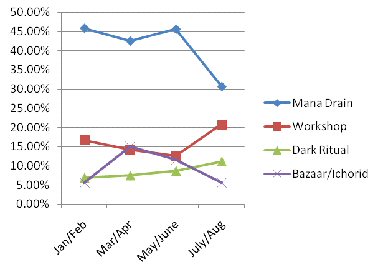
You can see the ups and downs of all of the archetypes since January. The June restrictions have resulted in a massive correction.
Now, take a look at the same chart since the restriction of Gush and company:
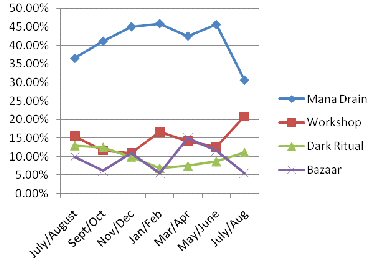
This chart shows the trends, too clear to ignore. In essence, the restriction of Gush put Drains on an upward trajectory, especially with the printing of Tezzeret and errata on Time Vault last September. The restriction of Thirst has resulted in a dramatic correction.
Now, click here to see our metagame engine chart since 2007.
So far, it appears that the DCI’s action is working. Tezzeret was far and away the best deck in Vintage, and Mana Drains were totally dominant. While Mana Drains appear to remain the best performers, they aren’t totally dominating Vintage like they were a few months ago. I hope these trends continue, and it’s not just a blip in the continuation of Drain dominance.
Analysis of the StarCityGames.com $5000 Charlotte Legacy Open
Hello to all Legacy fans out there! A few months ago, StarCityGames.com sent me all of the decklists from the inaugural SCG $5000 Legacy event. However, they didn’t get me the standings. Had they given me the standings, I could have performed a tournament metagame analysis I pioneered earlier this year, in my Waterbury analysis.
What I did there was to graph the distribution of particular archetypes across the standings. Usually, people only look at the decks that made Top 8 or Top 16, or for Pro Tours or Grands Prix Top 64 or Top 128. Or, if they provide a breakdown of the entire field, the only compare the percentage of a particular archetype in the Top 64, 16, 8 or whatever. Adrian Sullivan calls this “Top * penetration” to illustrate the proportion of a particular archetype in a particular segment of the top part of the field.
I think all of these approaches are important, and I will do the same thing, but the approach I used with the Waterbury tells us so much more. What I discovered there was that archetypes and decks cluster in very consistent patterns across the final standings. That’s why I asked SCG’s Jared Sylva for the standings as well as the decklists. I think you’ll find this quite interesting. But before that, let me show you a list with each player, what they played, where they ended up in the final tournament standings, and an archetype breakdown:
1 — Hatfield, Alix — Zoo (RGW)
2 — Woltereck, Chris E — 43 Land
3 — De Los Santos, Julian L — Zoo (RGW)
4 — Leigh, Joe — Counterbalance Goyf (UBG)
5 — Greenberg, Harrison J — Goblins (RW)
6 — Russ, Oliver — Dreadtill
7 — Bode, Jonathan — Zoo (RGW)
8 — Mcduffie, Korey — Goblins (RW)
9 — Usary, Marsh S — Zoo (RGW)
10 — Green, Robert L — Merfolk (Mono Blue)
11 — Whitby, Damon — Dredge
12 — Abbott, Jeff — BG Beats
13 — ward, mike — Merfolk (Mono Blue)
14 — Furrow, Tim — Zoo (RGW)
15 — Willson, Nikkoli D — Merfolk (Mono Blue)
16 — Schoenbach, Daniel — Merfolk (Mono Blue)
17 — Swartz, Josh — BGW Beats
18 — Thornton, Matthew J — Merfolk (Ugw)
19 — Bartholomew, Jon — Dredge
20 — Nestico, Adrian — Merfolk (Ug)
21 — davenport, eddie — Dreadtill
22 — Barrentine, Scott D — Merfolk (Mono Blue)
23 — Mayer, David — Counterbalance Goyf (UGWR)
24 — Hopkins, Aaron — Zoo (RGW)
25 — Mollenkopf, Tyler — Zoo (RGW)
26 — Lambeth, Jason V — Dredge
27 — Henricks, J.T. — Counterbalance Goyf (UBGW)
28 — Sale, Daniel — Dragon Stompy
29 — Dorsett, Neal — Canadian Threshold
30 — Gosche, Matt — Canadian Threshold
31 — Gibala, Ben J — Dredge
32 — Lanceford, Vincent M — Merfolk (UW)
33 — Price, David — UGW Threshold
34 — Lampron, Yan — Planeswalker Control
35 — VanWert, Chris C — Counterbalance Goyf (UGWR)
36 — Signorini, Daniel — Counterbalance Goyf (UGWR)
37 — Keller, Richard j — Burn
38 — Morris, Christopher — Suicide Black
39 — Haas, Brett E — Canadian Threshold
40 — Coppola, Christopher E — Counterbalance Goyf (Ugr)
41 — Duguay, Pierremarc — Canadian Threshold
42 — mercado, guillermo — Counterbalance Goyf (UBGW)
43 — Prentice, Phillip — Aggro Loam
44 — Parris, Robert W — Goblins (RB)
45 — Adams, Joshua — Zoo (RGW)
46 — Cannon, Chris S — Merfolk (UW)
47 — Cordoba, Rodrigo — Counterbalance Goyf (UGBR)
48 — Beasley, Orrin A — Dredge
49 — staffa, eric r — Counterbalance Goyf (UGR)
50 — Smith, Ben A — Zoo (RGW)
51 — Guy, Damion R — Dragon Stompy
52 — Nichols, Joey — Pox
53 — Guzzo, Matthew A — UGB Threshold
54 — King, Jonathan C — Counterbalance Goyf (UGWB)
55 — Bishop, James T — Canadian Threshold
56 — Deneka, Phillip M — Ad Nauseam
57 — Huttman, Michael R — Merfolk (Mono Blue)
58 — Tompkins, Mike — 43 Lands
59 — Thompson, Rory — Counterbalance Goyf (UGW)
60 — Andrews, Kevin — Burn
61 — Adams, Ken G — Dreadtill
62 — Lynch, Jay — Pox
63 — Nava, John — Counterbalance Goyf (UGBW)
64 — McCraw, Stephen N — Ad Nauseam
65 — Johnson, Richard — Dredge
66 — Calvo, Philip S — GB Beats
67 — Lewis, Michael W — Merfolk (UG)
68 — corter, bryant c — Mono-White Stax
69 — Hatfield, Jesse — Zoo (RGW)
70 — Losey, Anthony — Affinity
71 — Gilliam, Jeremy A — Zoo (RGW)
72 — Brisendine, J. B. — UGB Threshold
73 — Gosse, Eric W — UGB Threshold
74 — Haley, Dustin J — GB Beats
75 — Osborne, Brian — Ad Nauseam
76 — Diefendorf, Brian — Zoo (RGW)
77 — Mills, Justin E — Counterbalance Goyf (UGBW)
78 — Petit, Ben F — Goblins (RB)
79 — Frank, Harry L — Painter Combo
80 — Tanner, Byron — Pox
81 — Parnell, Justin M — BGw Beats
82 — De Candio, Brennan M — UBG Threshold
83 — McCoy, Douglas — BGw Beats
84 — little, patrick b — BGw Beats
85 — Nash, Matt — 43 Lands
86 — Chatham, Charles E — Zoo (RG)
87 — Ortiz, Gus — Zoo (RG)
88 — Sanders, Corey B — Dredge
89 — Davis, John W — UG Aggro-Control
90 — Sanders, Taylor — UG Madness
91 — Cain, Lee E — Affinity
92 — Pagnani, Alex R — Dreadtill
93 — Nisthal, Daniel — Imperial Painter Combo
94 — King, Hugh S — Counterbalance Goyf (UBGW)
95 — McCoy, Christopher — UB Faeries
96 — Riley, Michael S — Affinity
97 — White, Zak — Elves
98 — Rogers, Jerry W — UR Fish
99 — Edwards, Tyler B — Planeswalker Control
100 — Pogue, James S — Canadian Threshold
101 — Cai, Adam — Dreadtill
102 — Hall, Mike A — Merfolk (UG)
103 — Werner, Nicholas — Pox
104 — Stinnett, Johnathan l — Ad Nauseam
105 — Young, Scott — Elves Combo
106 — Haley, Michael — Planeswalker Control
107 — Dodd, Thomas — RGB Burn/Beats
108 — Williams, Christopher L — Merfolk (Mono Blue)
109 — Marshall, Phillip — Burn
That translates into the following breakdown by archetype:
14 Zoo
14 Counterbalance Goyf
13 Merfolk
7 BG or BG(w) Beats
7 Dredge
6 Canadian Threshold
5 Dreadtill
4 Goblins
4 Pox
4 Ad Nauseam
4 Ugb Threshold
1 Ugw Threshold
1 UG Threshold
3 Burn
3 43 Land
3 Planeswalker Control
3 Affinity
2 Elves
2 Dragon Stompy
1 Suicide Black
1 Aggro Loam
1 Mono-White Stax
1 Painter Control
1 Imperial Painter
1 Madness
1 UB Faeries
1 UR Fish
1 RBG Burn
Unlike my previous SCG $5000 breakdown, I haven’t listed each of the particular sub-archetypes (such as the various color permutations for Counterbalance-Goyf) simply because you can see that for yourself in the table above.
Without question, RGW Zoo was the best performing deck in this tournament, with Merfolk just behind them. What’s interesting is this: Merfolk and Fish were the first and the third most popular archetypes, respectively, but they were by far the most successful in penetrating the Top 16 and Top 32.
I will visually graph this for you in just a moment, but there were five RGW Zoo decks in the Top 16, and four Merfolk decks in the Top 16. The difference, however, is this: All of the Merfolk decks fell in the bottom half of the Top 16. In other words, although Merfolk were very strong performers, with the second-greatest amount of representation in the Top 16 of any archetype, none of the Merfolk decks made Top 8. Not one!
Not only that, but three of the five Zoo decks in the Top 16 fell in the Top 8, including the first and third place decks. There is absolutely no doubt about it. Zoo was by far the best performing deck in this tournament when you look at all of the facts.
There is no doubt that Merfolk did very well. Take a look at this chart showing their distribution through the field.
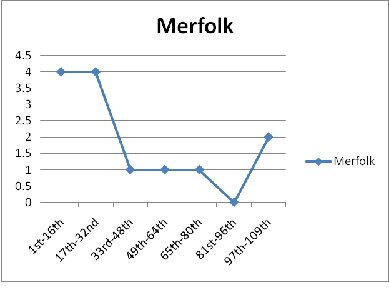
Here are some telling stats this chart reveals: Merfolk were also the most represented archetype in the Top 32, with 8 representatives, compared to Zoo’s 7.
However, Zoo was the best performing deck overall.
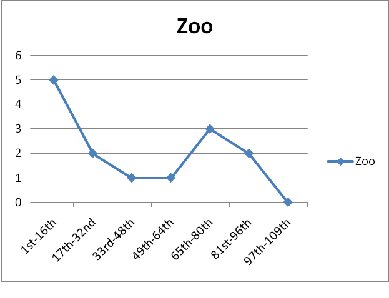
This graph shows two clear peaks. While Zoo decks were distributed throughout the field except the very bottom, they peak at the very top of the tournament, with a second peak between 65th and 80th place. This shows that unlike Merfolk, an appreciable number of Zoo decks got stuck in the bottom half of the tournament, although not in the bottom 32 of the tournament. That’s important, because it means that none of the Zoo players were quickly eliminated from the tournament, unlike BG Beats (Eva Green) or Ad Nauseam, for example;
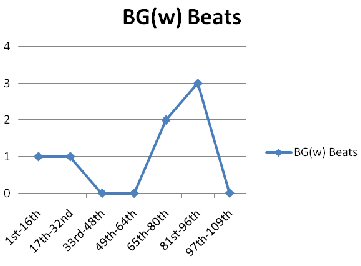
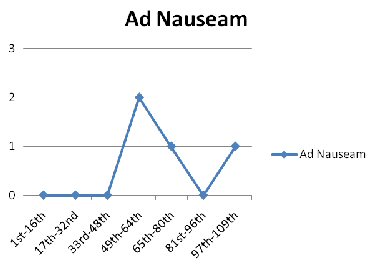
These decks were popular, but very poor performers. Not a single Ad Nauseam deck made the Top 48; rather pathetic. More strikingly, BG decks were huge losers. These decks clustered near the very bottom of the tournament. I would not recommend that archetype to anyone in the near future.
The best performing archetype in the previous tournament was Dreadtill. Comparatively, Dreadtill had a dreadful tournament. There were only five present, but they were as likely to fall in the Top 32 as they were in the bottom 32.
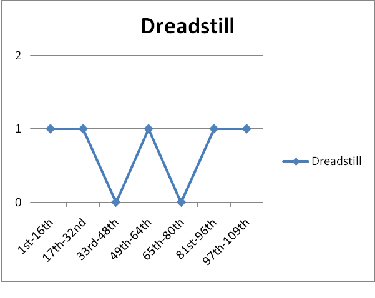
I think we can understand why. Qasali Pridemage is the new tech since the last tournament. It’s in almost all of the RGW Zoo lists.
One other surprise was Goblins:
Goblins has gotten new tools with M10, and it shows. There were only 4 Goblins decks present, but half of them made Top 16!
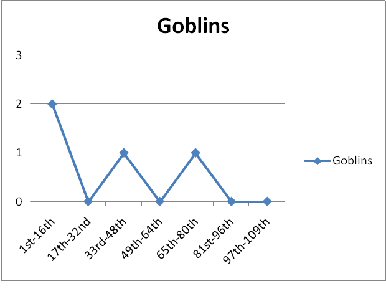
But what about the Grand Prix: Chicago winner? What about Counterbalance-Goyf decks? Well, take a look at this:
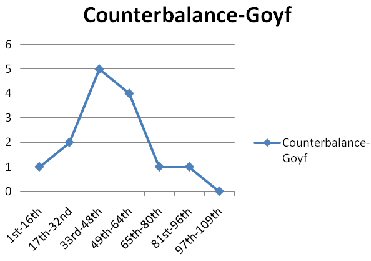
This chart tells us everything we need to know. It was the tied for the most popular archetype, but it clustered in a very specific location. 65% of this archetype finished in the second quartile, between 32nd and 64th place. It’s clear that this archetype just faced too many difficult matchups, whether that meant Zoo and Merfolk or both, and I suspect that and more.
One last note on archetypes: Canadian Threshold has been a very popular archetype recently, particularly with its success at the Legacy Championships this year. It turns out that this archetype clustered between 17-48th place, with four of its six representatives falling there. I think that tells us something about it in this metagame: it was a decent choice, in that it won a lot of games, but it just wasn’t good enough to penetrate the very top. I think we can all see why: The Zoo decks.
Zoo has completely reshaped the Legacy metagame in evident ways that can only be fully understood with the type of analysis I just ran through, in looking at where archetypes clustered in the field.
Just for comparison, here is a chart that has the graphs of the three most popular archetypes, so you can see how they compare:
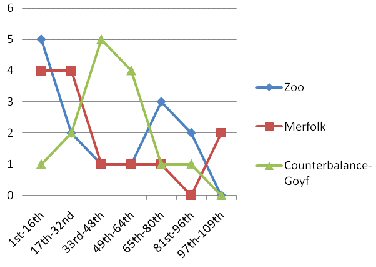
I strongly encourage writers for other formats, such a Standard, to perform this sort of analysis to understand the dynamics of their metagame with greater precision.
In the last tournament analysis, I observed that Goyf decks made up 45% of the field, which I was very surprised by. In this tournament, there were 52 Goyf decks, for a remarkable 47.7% of the field!
If you competed in this tournament, you had almost a 50% chance of facing Tarmogoyf every round! That may be a problem for Legacy.
Until next time…
Tournament Appendix: July/August Top 8s
July:
Rome.
TPS won
ICBM Open Day 1.
BUG Fish Won
ICBM Open Day 2.
UBW Fish Won
Spain.
Drain Tendrils Won
August:
Vintage Worlds.
Tez Won
Manila.
Dredge Won
NY.
Dredge Won
Mungia, Spain.
European Storm Combo
Badalona, Spain.
UGW Fish won

